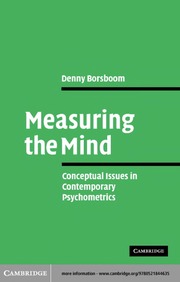 | |
| Author | Denny Borsboom |
|---|---|
| Publisher | Cambridge University Press |
Publication date | 2005 |
| Media type | Hardcover |
| Pages | 183 |
| ISBN | 978-0-521-84463-5 |
| OCLC | 254153121 |
| 150.15195 22 | |
| LC Class | BF39 .B693 2005 |
Measuring the Mind: Conceptual Issues in Contemporary Psychometrics [1] is a book by Dutch academic Denny Borsboom, Assistant Professor of Psychological Methods at the University of Amsterdam, at time of publication. [2] The book discusses the extent to which psychology can measure mental attributes such as intelligence and examines the philosophical issues that arise from such attempts.
Contents
The book examines three major models within psychometrics; classical test theory/true scores, latent variables/item response theory and representational measurement theory. Each theory is examined against three perspectives or “stances”:
- The formal stance: how the model is formulated in terms of its syntax and semantics
- The empirical stance: how the model handles data in empirical research
- The ontological stance: whether the psychometric concepts of the model are useful fictions or are part of an objective, external reality
The book also examines the relationship between the three models and finally ends with a discussion on the concept of validity.